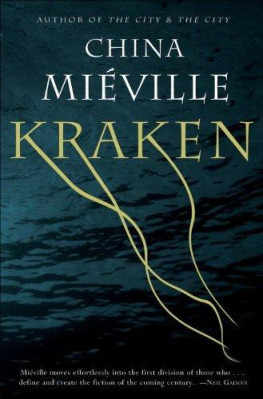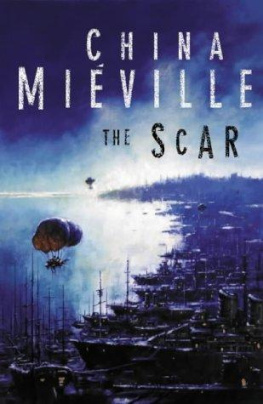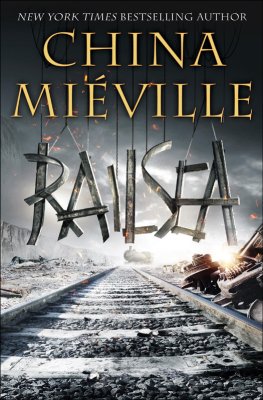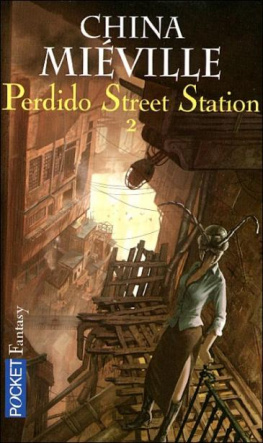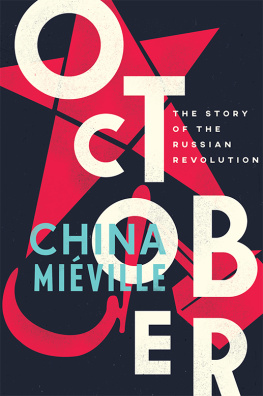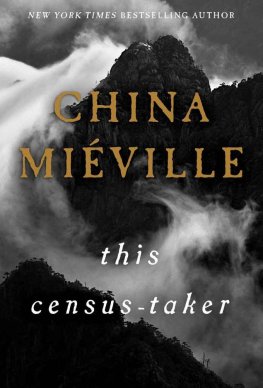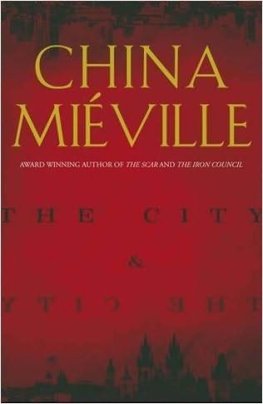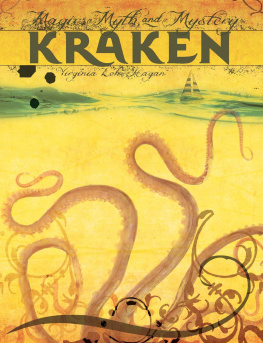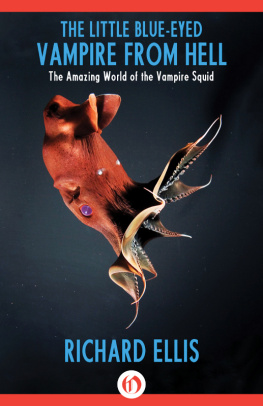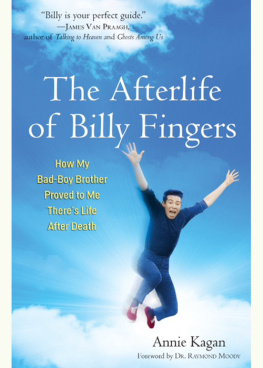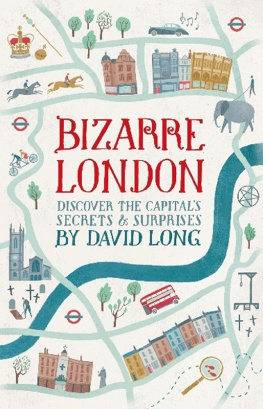ALSO BY CHINA MIVILLE King Rat Perdido Street Station The Scar Iron Council Looking for Jake: Stories Un Lun Dun The City & The City

To Mark Bould
Comrade-in-tentacles
ACKNOWLEDGMENTS For all their help with this book Im extremely grateful to Mark Bould, Mic Cheetham, Julie Crisp, Melisande Echanique, Penelope Haynes, Chloe Healy, Kaitlin Heller, Deanna Hoak, Simon Kavanagh, Peter Lavery, Jemima Miville, David Moensch, Sandy Rankin, Max Schaefer, Jesse Soodalter, and to my editors Chris Schluep and Jeremy Trevathan. My sincere thanks to all at Del Rey and Macmillan.The Natural History Museum and Darwin Centre are, of course, real placesthe latter containing a real Architeuthis but the questionable versions depicted here are entirely my responsibility. For their extraordinary hospitality and behind-the-scenes access, I am enormously grateful to those who work in the real institutions, particularly Patrick Campbell, Oliver Crimmen, Mandy Holloway, Karen James, and John Lambshead.The poem in , The Kraken Wakes, is copyright Hugh Cook, and I am very grateful to his family for permission to reproduce it. Among the countless writers, musicians, artists, and researchers to whom Im indebted, those Im particularly aware of and grateful to with regard to this book include Hugh Cook, Burial, Hugh Harman and Rudy Ising, William Hope Hodgson, Pop Will Eat Itself, Tsunemi Kubodera and Kyoichi Mori, Jules Verne, H. G. Wells, and Japetus Steenstrup.
Contents
The green waves break from my sides
As I roll up, forced by my seasonH UGH C OOK , The Kraken Wakes T he sea is full of saints. You know that? You know that: youre a big boy . The seas full of saints and its been full of saints for years. Since longer than anything. Saints were there before there were even gods. They were waiting for them, and theyre still there now . Saints eat fish and shellfish. Some of them catch jelly fish and some of them eat rubbish. Some saints eat anything they can find. They hide under rocks; they turn themselves inside out; they spit up spirals. Theres nothing saints dont do . Make this shape with your hands. Like that. Move your fingers. There, you made a saint. Look out, here comes another one! Now theyre fighting! Yours won . There arent any big corkscrew saints anymore, but there are still ones like sacks and ones like coils, and ones like robes with flapping sleeves. Whats your favourite saint? Ill tell you mine. But wait a minute, first, do you know what it is makes them all saints? Theyre all a holy family, theyre all cousins. Of each other, and of you know what else theyre cousins of? Thats right. Of gods . Alright now. Who was it made you? You know what to say . Who made you?
PART ONE
SPECIMENS
Chapter One
A N EVERYDAY DOOMSAYER IN SANDWICH-BOARD ABRUPTLY walked away from what over the last several days had been his pitch, by the gates of a museum. The sign on his front was an old-school prophecy of the end: the one bobbing on his back read FORGET IT .
I NSIDE, A MAN WALKED THROUGH THE BIG HALL, PAST A DOUBLE stair and a giant skeleton, his steps loud on the marble. Stone animals watched him. Right then, he kept saying.
His name was Billy Harrow. He glanced at the great fabricated bones and nodded. It looked as if he was saying hello. It was a little after eleven on a morning in October. The room was filling up. A group waited for him by the entrance desk, eyeing each other with polite shyness.
There were two men in their twenties with geek-chic haircuts. A woman and man barely out of teens teased each other. She was obviously indulging him with this visit. There was an older couple, and a father in his thirties holding his young son. Look, thats a monkey, he said. He pointed at animals carved in vines on the museum pillars. And you see that lizard?
The boy peeped. He looked at the bone apatosaurus that Billy had seemed to greet. Or maybe, Billy thought, he was looking at the glyptodon beyond it. All the children had a favourite inhabitant of the Natural History Museums first hall, and the glyptodon, that half-globe armadillo giant, had been Billys.
Billy smiled at the woman who dispensed tickets, and the guard behind her. This them? he said. Right then, everyone. Shall we do this thing?
H E CLEANED HIS GLASSES AND BLINKED WHILE HE WAS DOING IT, replicating a look and motion an ex had once told him was adorable. He was a little shy of thirty and looked younger: he had freckles, and not enough stubble to justify Bill. As he got older, Billy suspected, he would, DiCaprio-like, simply become like an increasingly wizened child.
Billys black hair was tousled in halfheartedly fashionable style. He wore a not-too-hopeless top, cheap jeans. When he had first started at the centre, he had liked to think that he was unexpectedly cool-looking for such a job. Now he knew that he surprised no one, that no one expected scientists to look like scientists anymore.
So youre all here for the tour of the Darwin Centre, he said. He was acting as if he thought they were present to investigate a whole research site, to look at the laboratories and offices, the filing, the cabinets of paperwork. Rather than to see one and only the one thing within the building.
Im Billy, he said. Im a curator. What that means is I do a lot of the cataloguing and preserving, stuff like that. Ive been here awhile. When I first came here I wanted to specialise in marine molluscsknow what a mollusc is? he asked the boy, who nodded and hid. Snails, thats right. Mollusca had been the subject of his masters thesis.
Alright, folks. He put his glasses on. Follow me. This is a working environment, so please keep the noise down, and I beg you not to touch anything. Weve got caustics, toxins, all manner of horrible stuff all over the place.
One of the young men started to say, When do we see? Billy raised his hand.
Can I just ? he said. Let me explain about whatll happen when were in there. Billy had evolved his own pointless idio-superstitions, according to one of which it was bad luck for anyone to speak the name of what they were all there for, before they reached it.
Im going to show you a bunch of the places we work, he said lamely. Any questions, you can ask me at the end: were a little bit time constrained. Lets get the tour done first.
No curator or researcher was obliged to perform this guide-work. But many did. Billy no longer grumbled when it was his turn.
They went out and through the garden, approaching the Darwin with a building site on one side and the brick filigrees of the Natural History Museum on the other.
No photos please, Billy said. He did not care if they obeyed: his obligation was to repeat the rule. This building here opened in 2002, he said. And you can see were expanding. Well have a new building in 2008. Weve got seven floors of wet specimens in the Darwin Centre. That means stuff in Formalin.
Everyday hallways led to a stench. Jesus, someone muttered.
Indeed, said Billy. This is called the dermestarium. Through interior windows there were steel containers like little coffins. This is where we clean up skeletons. Get rid of all the gunk on them. Dermestes maculatus.
A computer screen by the boxes was showing some disgusting salty-looking fish being eaten by insect swarms. Eeurgh, someone said.
Theres a camera in the box, said Billy. Hide beetles is their English name. They go through everything, just leave bones behind.
The boy grinned and tugged his fathers hand. The rest of the group smiled, embarrassed. Flesh-eating bugs: sometimes life really was a B-movie.
Billy noticed one of the young men. He wore a past-it suit, a shabby-genteel outfit odd for someone young. He wore a pin on his lapel, a design like a long-armed asterisk, two of the spokes ending in curls. The man was taking notes. He was filling the pad he carried at a great rate.

